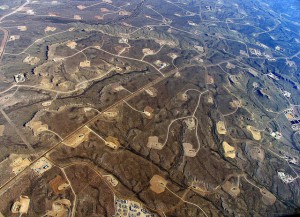Preempting a Misleading Argument: Why Environmental Problems Will Stop Tracking with GDP
by Brian Czech
I hate to say I told you so, and could be too dead to do so, so I’ll tell you in advance: One decade soon, environmental problems will stop tracking with GDP.
But the reasons? Well, they probably aren’t what you think, especially if you’ve been drinking the green Kool-Aid.
For decades, big-picture ecologists and eventually the “ecological economists” pointed out the fundamental conflict between economic growth and environmental protection. Every tick of GDP came with the tock of habitat loss, pollution, and, as we gradually realized, climate change. A growing GDP requires a growing human population or a growing amount of goods and services per person. In the American experience of the 20th century, it was easy to see both – population and per capita consumption – spiraling upward, and just as easy to see the environmental impacts reverberating outward. Much of the world saw the same, although in some countries GDP growth was driven almost entirely by population growth.

In areas where shale-drilling/hydraulic fracturing is heavy, a dense web of roads, pipelines, and well pads turn continuous forests and grasslands into fragmented islands. Photo Credit: Simon Fraser University
Unfortunately, a lot of time was spent overcoming fallacious but slick-sounding shibboleths like “green growth,” “dematerializing” the economy, and the “environmental Kuznets curve.” It seemed these were – or easily could have been –designed by advertisers on Madison Avenue, Big Money in general, or economists in their service, to prevent consumers and policy makers from responding rationally to environmental deterioration. Suggestive phrases such as “consumer confidence” spurred the consumer along, buying more stuff to increase the profits of corporations and, in turn, the campaign purses of politicians.
Meanwhile, those who studied, wrote, or simply worried about the effects of economic growth on the environment (and therefore the future economy) were portrayed and marginalized as tree huggers, earth firsters, or, as I once heard them called by a Scotland Yard detective at an intelligence conference, “the great unwashed.”
Some of us had to go so far as debating economists and, shockingly, ecologists who parroted the 1990’s political rhetoric that “there is no conflict between growing the economy and protecting the environment.” I even debated a future president of The Wildlife Society (TWS), who at the time was a biologist employed by the timber industry and a gadfly in TWS attempts to formulate a TWS position on economic growth. After our debate, I was told he was roundly defeated, and in subsequent years he refrained from the win-win rhetoric. (Hopefully it was that ability to reconnoiter with the truth that explains his electoral victory.)
Those of us who recognized the conflict between economic growth and environmental protection won the debates because we were right and we demonstrated it, ad nauseum, theoretically and empirically. We had to study the issue up and down, inside and out, because Big Money had far more resources to try defeating us at every turn. Eventually we published enough articles, organized enough conferences, and won enough debates that today, at least in professional natural resources circles, you’d seem, well… no smarter than a hedgehog if you tried to claim we can have our cake and eat it too.
So it is with ample irony that soon enough, we’ll enter an age where GDP won’t track with biodiversity loss, pollution, climate change, and other indicators of environmental deterioration. Why? Because, at some point during the 21st century and perhaps very soon, there won’t be enough resources left for GDP growth. Just as surely as the conflict between economic growth and environmental protection, there is a limit to growth, and it’s not as far off as the growth polyannas would have you think.
Let’s consider what happens to biodiversity – nonhuman species in particular – in the days beyond growth. Long after GDP growth grinds to a halt, biodiversity will continue declining for two reasons. The first is that many of the environmental effects of earlier GDP growth will be delayed. For example, when a species’ habitat is degraded by a pipeline here and a timber sale there, the species doesn’t instantly disappear. Yet a marginal drop in the rate of reproduction and a marginal increase in the rate of mortality can put the species on a path to extinction just as surely as you pay taxes.
Furthermore, habitat degradation can itself be a drawn-out process. The polar ice caps are on their way out, and polar bears along with them. Yet the ice won’t be gone and the polar bear won’t be extinct for some decades, probably well after GDP has stopped growing. And the polar bear is on the tip of the iceberg, as species en masse may be ushered off the poles as if on some geological conveyor belt running at the speed of climate change.
The second reason biodiversity will continue to decline long after GDP stops growing is because the cessation of GDP growth doesn’t mean corporations and countries will stop trying to grow the GDP. Far from it. As long as economic growth remains the primary policy goal of nations, the environmental impact of pursuing such growth will worsen, because nations will be pulling out all the stops to achieve it. This too is a process already underway; witness the mining of tar sands for exceedingly crude oil.
Yet tough times for the truth await because the next wave of polyannas will be busy perverting the truth from a different angle. Instead of arguing that GDP growth was a benefit to biodiversity – with the shallow argument that it put more money into conservation programs – they’ll be pointing to the fact that species are declining despite no growth in GDP. “Where’s the correlation,” they’ll ask, “between GDP and biodiversity loss?”
Alas, we’ve been careful all along, as good scientists are, to note that correlation doesn’t prove causality. Likewise, a lack of correlation doesn’t disprove causality. Economic growth – increasing production and consumption of goods and services in the aggregate, entailing a growing population and per capita consumption – has been the limiting factor for wildlife in the aggregate for the broad sweep of Homo sapiens’ reign on Earth. Beginning in the 1930s such growth was measured with GDP, and beginning in the 1970s species endangerment in the U.S. was measured by the length of the list of federally listed threatened and endangered species.
For decades the correlation between GDP and species endangerment was like the correlation between chickens and eggs. A statistic called the R-squared value was even used to measure just how tight. As such, the correlation was simply additional, circumstantial evidence for the conflict between economic growth and biodiversity conservation. It was never essential, though, for it was bloodily evident that the causes of species endangerment were a list of economic sectors, infrastructure, and byproducts. To think it wasn’t the economy causing all that species endangerment was like thinking all that lung cancer in the 70’s had nothing to do with cigarettes.
Now when the Marlboro man stopped smoking, he didn’t stop choking. No, he continued choking, all the way to death, from lung cancer and chronic obstructive pulmonary disease. But hey, in those final non-smoking years, the correlation between cigarettes and cancer cells was non-existent. Would anyone put it past Big Tobacco (the Seven Dwarves come to mind) to use this lack of correlation as evidence that tobacco doesn’t cause cancer?
Didn’t think so.
Well, Big Money – Wall Street, Madison Avenue, K Street too – we’re on to you. We know you’ll claim in decades to come that economic growth is not the cause of environmental deterioration. You’ll use the lack of correlation between GDP and species listings as one of your unscrupulous arguments. And you’ll be as wrong then as you have been heretofore.
Stick that in your pipe and smoke it preemptively.



I have just read Brian Czech’s recent article, predicting how the “economic Growth for Ever” brigade will seek to show that Economic Growth cannot be held responsible for the continued decline in the populations of plant and animal species if growth in global GDP ever became zero while the decline continued. This would, of course, be an extremely bizarre misuse of statistics, showing no awareness of cause and effect, which can easily be refuted by applied common sense.
Something which concerns me much more is the sad fact that political parties, seeking to gain control of the lives of the ordinary people in their countries, have one thing in common; they are hopeless at analysing problems, whose effects will be apparent on a timescale well beyond the date of the next election. They want to be seen to be doing something attractive for their prospective voters in the short term and must never ever talk about more serious longer term problems in case they frighten their voters away.
A good example of this has been the recent general election in the UK which was won by the Conservative party for a variety of reasons which are still being analysed by a host of self-styled experts, but probably related to the fact that the previous Conservative-controlled coalition government was able to sell the idea that they were more likely to tackle deficit reduction and move on to debt reduction in due course; i.e. the economy was in safe hands and the message was ” don’t rock the boat”. The result of the election was a big surprise to most of us, but I’m afraid the country has chosen the “least worst” party to look after us for the next 5 years. The truth is that none of the parties could have been able to face up to reality in the run up, because to do so would have been electoral suicide. They all wanted to paint a picture of onwards and up-words in a world of never-ending growth, with increasing prosperity without any of them having the slightest idea about where the growth was going to come from. when all the evidence staring us in the face is that “things ain’t what they used to be”, and . never will be again. Sadly this wishful thinking, to the tune of “Somewhere, over the rainbow”, is shared by the European Union, The IMF, and, I’m sure, political parties in the USA.
I thought I would gather some data about the UK, which would help to analyse the nature of the problems facing us, if we look well beyond the next five years until the next election, which, I guess, is as far ahead as any politician can see, whether or not he understands the niceties of exponential growth curves.. A prime example of this in our recent election were promises by all parties to maintain our NHS as an essentially free service to the nation for all time, just as it was set up in 1948. It only takes a few minutes on the internet to dig out some facts which show how far-fetched this idea is.
In 1950 the NHS expenditure in today’s money was £9B, while the figure for 2015 is £115.48 B, for populations of 54.3m and 63.8M respectively. The cost per head has therefore risen from £166 to £1802 in this time, which represents an exponential rise of 3.6% per head per year, which can be explained in terms of the costs of the many technological improvements in detection and treatment of illness. The paradoxical outcome of this has been the substantial rise in life expectancy, which increases the costs of the service.
A figure of 3% might not sound too bad since it is the same ball park as other increases, not necessarily annual, we are used to for utilities, but the problem for the nation comes from the nature of remorseless exponential rises over many years, which governments should, but don’t, take into account. For example if NHS costs continue to increase at the current rate, by the end of the century the NHS bill per head would rise from £1800 per year now to £36000 in 2100., but we then have to take into account the estimated population in 2100, to predict the NHS bill then.
For this we need to have population figures over the period. From 1950 to 2000 our population grew at an exponential rate of around 0.2% per year. Since 2000 the population growth rate has increases appreciably to 0.6%, influenced by a number of factors, including immigration, birth rate and increased life expectancy. This figure of 0.6% per annum is currently being used to forecast housing needs until 2030. Looking ahead to 2100, if this population growth rate is maintained the population of the UK will have reached 106 million, a rise of 66% on the current figure and the NHS bill, were it to be maintained, would far exceed our GDP.
On the basis of this analysis of data the NHS in its current form must be completely unsustainable, and the longer politicians turn a blind eye to this the worse will be the consequences for the country.
Applying this approach to other “hot” topics like education, housing shortages, job creation, which politicians are happy to “solve” with quick fixes and sound bites, one quickly comes to the conclusion that the real underlying problem in all of this is population growth, which is the one thing that none of them will dare to mention. We constantly hear complaints from parties not in power that we need more houses, hospitals, schools, doctors, nurses, midwives, policemen, jobs, roads, railways etc. etc, but never ever the suggestion that we have too many people! The old adage that there are none so blind as will not see, was never more true.
It should be clear from this that the UK should make a serious effort to get its population stabilised as soon as possible if we have any ambitions to maintain anything like a reasonable quality of life. Any attempt to achieve a Steady State Economy must involve achieving a steady state population. I believe Winston Churchill, in a reply to an opposition demand to tax the wealthy to give to the poor to create equality, once remarked that we had two choices for our country, we could have a country with a range of rich and poor or we could all be equally poor! How true!
One of the more illuminating facts coming out from trolling through available data is a comparison of current population figures across the world from which we find that Germany has a population growth of -0,21% per annum, i.e shrinking.
I know who will be better placed as far as quality of life goes in 2100.